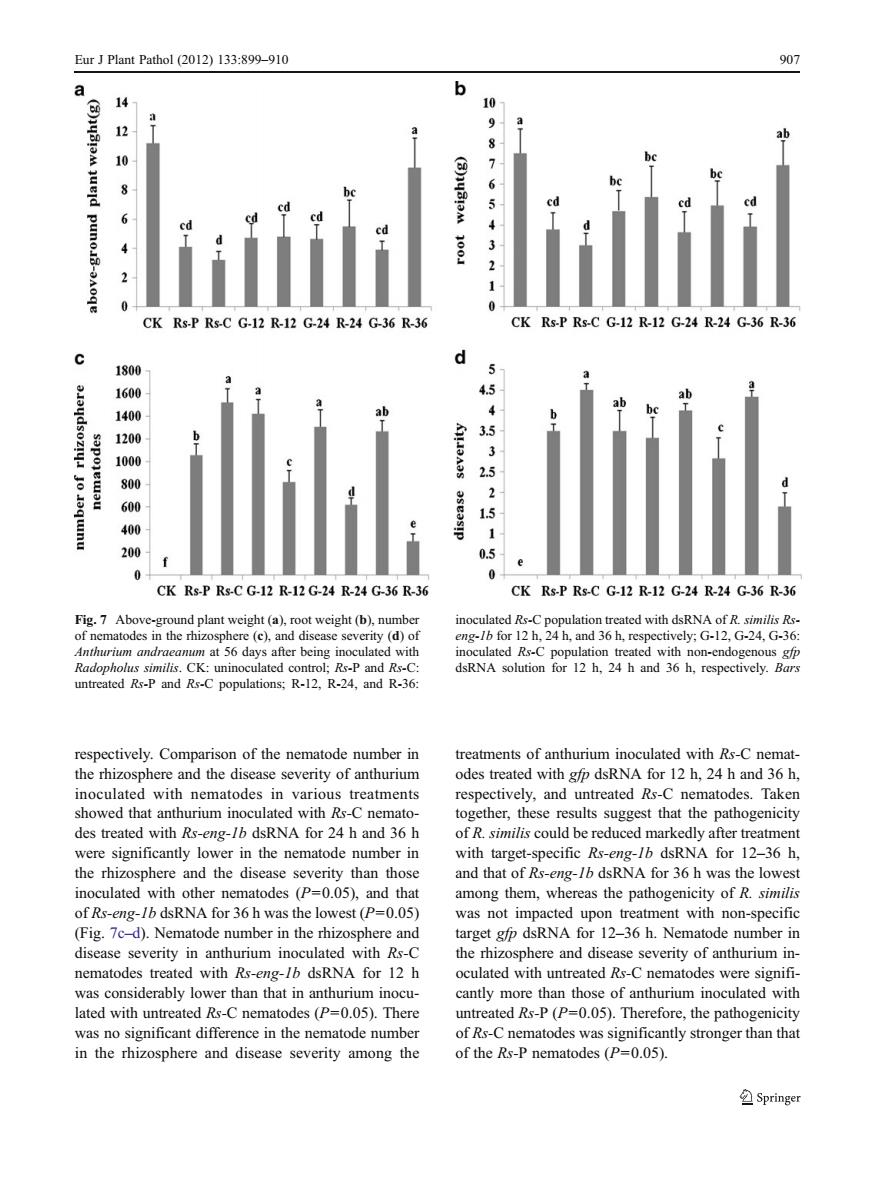正在加载图片...

Eur J Plant Pathol (2012)133:899-910 907 a b 10 CK Rs-P Rs-C G-12 R-12 G-24 R-24 G-36 R-36 CK Rs-P Rs-C G-12 R-12 G-24 R-24 G-36 R-36 d 1800 10 CK Rs-P Rs-C G-12 R-12 G-24 R-24 G-36 R-36 CK Rs-P Rs-C G-12 R-12 G-24 R-24 G-36 R-36 noatecdRs-Cpopultiom,rated 36 untreated Rs-P and Rs-C populations:R-12.R-24.and R-36 respectively.Comparison of the nematode number in treatments of anthurium inoculated with rs-c nemat the rhizosphere and the disease severity of anthurium odes treated with gfp dsRNA for 12 h,24 h and 36 h, inoculated with nematodes in various treatments respectively,and untreated Rs-C nematodes.Taken showed that anthurium inoculated with rs-c nemato together,these results suggest that the pathogenicity des treated with Rs-eng-/b dsRNA for 24 h and 36 h of r.similis could be reduced markedly after treatmen were significantly lower in the nematode number in with target-specific Rs-eng-16 dsRNA for 12-36 h the rhizosphere and the disease severity than those and that of Rs-eng-Ib dsRNA for 36 h was the lowes inoculated with other nematodes (P=0.05).and tha among them,whereas the pathogenicity of R.similis of Rs-eng-1b dsRNA for 36 h was the lowest (P=0.05) was not impacted upon treatment with non-specific (Fig.7c-d).Nematode number in the rhizosphere and target gio dsRNA for 12-36 h.Nematode number in disease severity in anthurium inoculated with Rs-C the rhizosphere and disease severity of anthurium in nematodes treated with Rs-eng-/b dsRNA for 12 h oculated with untreated Rs-C nematodes were signifi was considerably lower than that in anthurium inocu cantly more than those of anthurium inoculated with lated with untreated Rs-C nematodes (P-0.05).There untreated Rs-P(P=0.05).Therefore,the pathogenicity was no significant difference in the nematode number of Rs-C nematodes was significantly stronger than that in the rhizosphere and disease severity among the of the Rs-P nematodes (P=0.05) Spring respectively. Comparison of the nematode number in the rhizosphere and the disease severity of anthurium inoculated with nematodes in various treatments showed that anthurium inoculated with Rs-C nematodes treated with Rs-eng-1b dsRNA for 24 h and 36 h were significantly lower in the nematode number in the rhizosphere and the disease severity than those inoculated with other nematodes (P00.05), and that of Rs-eng-1b dsRNA for 36 h was the lowest (P00.05) (Fig. 7c–d). Nematode number in the rhizosphere and disease severity in anthurium inoculated with Rs-C nematodes treated with Rs-eng-1b dsRNA for 12 h was considerably lower than that in anthurium inoculated with untreated Rs-C nematodes (P00.05). There was no significant difference in the nematode number in the rhizosphere and disease severity among the treatments of anthurium inoculated with Rs-C nematodes treated with gfp dsRNA for 12 h, 24 h and 36 h, respectively, and untreated Rs-C nematodes. Taken together, these results suggest that the pathogenicity of R. similis could be reduced markedly after treatment with target-specific Rs-eng-1b dsRNA for 12–36 h, and that of Rs-eng-1b dsRNA for 36 h was the lowest among them, whereas the pathogenicity of R. similis was not impacted upon treatment with non-specific target gfp dsRNA for 12–36 h. Nematode number in the rhizosphere and disease severity of anthurium inoculated with untreated Rs-C nematodes were significantly more than those of anthurium inoculated with untreated Rs-P (P00.05). Therefore, the pathogenicity of Rs-C nematodes was significantly stronger than that of the Rs-P nematodes (P00.05). Fig. 7 Above-ground plant weight (a), root weight (b), number of nematodes in the rhizosphere (c), and disease severity (d) of Anthurium andraeanum at 56 days after being inoculated with Radopholus similis. CK: uninoculated control; Rs-P and Rs-C: untreated Rs-P and Rs-C populations; R-12, R-24, and R-36: inoculated Rs-C population treated with dsRNA of R. similis Rseng-1b for 12 h, 24 h, and 36 h, respectively; G-12, G-24, G-36: inoculated Rs-C population treated with non-endogenous gfp dsRNA solution for 12 h, 24 h and 36 h, respectively. Bars Eur J Plant Pathol (2012) 133:899–910 907